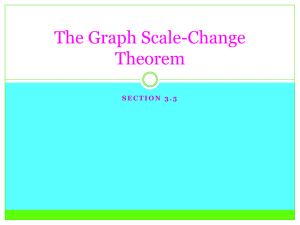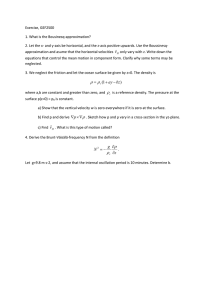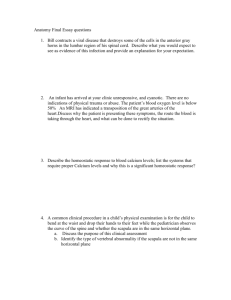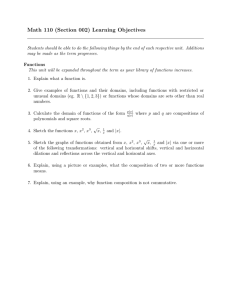14 th Congress of the ... Hamburg 1980 Commission Presented Paper
advertisement
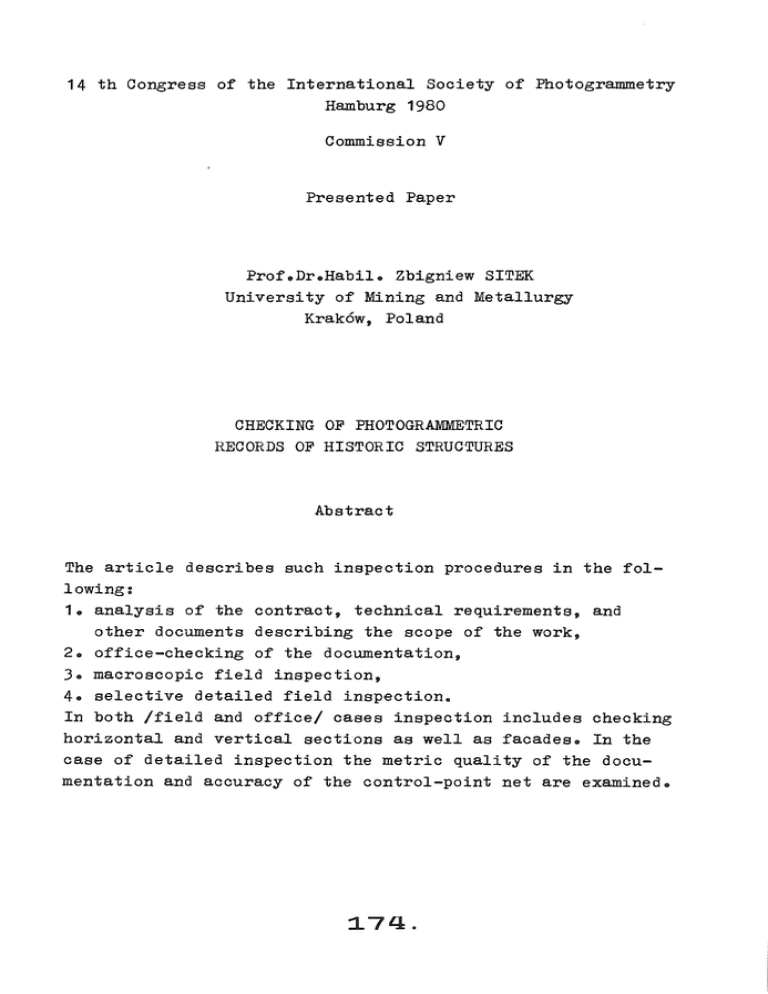
14 th Congress of the International Society of Photogrammetry Hamburg 1980 Commission V Presented Paper Prof.Dr.Habil. Zbigniew SITEK University of Mining and Metallurgy Krakow, Poland CHECKING OF PHOTOGRAMMETRIC RECORDS OF HISTORIC STRUCTURES Abstract The article describes such inspection procedures in the following: 1. analysis of the contract, technical requirements, and other documents describing the scope of the work, 2. office-checking of the documentation, 3e macroscopic field inspection, 4. selective detailed field inspection. In both /field and office/ cases inspection includes checking horizontal and vertical sections as well as facades. In the case of detailed inspection the metric quality of the documentation and accuracy of the control-point net are examined. Connnission V Prof.Dr. Zbigniew Sitek University of Mining and Metallurgy, Krak6w, Poland CHECKING OF PHOTOGRAMMETRY RECORDS OF HISTORIC STRUCTURES Abstract The article describes such inspection procedures in the following: 1. analysis of the contract, technical requirements, and other documents describing the scope of the work, 2. office-checking of the documentation, 3. macroscopic field inspection, 4• selective detailed field inspection. In both /field and office/ cases inspection includes checking horizontal and vertical sections as well as facades. In the case of detailed inspection the metric quality of the documentation and accuracy of the control-point net are examined. Irrespective of ability, scrupulosity and engagement of the performer - each architectural inventarization should be controled. It is not important who will do the checking, but it must be complex and compre.hensi ve. One can perform the control in the following steps: I. Analysis of the contract, technical conditions and other documents describing the scope of work, II. Office control, III. Field macroscopic checking, IV. Detailed field control in chosen areas. :175. I. Analysis of the contract, technical conditions and other agreements between the contractor and the employer allow for a comparison of the range of work. A well-expressed contract and particularly precisly formulated technical conditions should give an unambiguous estimation of the range of work. The analysis is based on a comparison of the work indicated in the contract with work which was done in the procedure of inventarization. /The number of external and internal elevations, number of vertical and horizontal sections, views, details etc./. The form of documentation must be also checked. Such analyses and comparisons give the contractor the assurance that all the work was done, or that some of it must be completed. II. Office control is taking into account: a- documentation completeness, b- graphical /or photographic/ similarity, c- relative compatability of vertical and horizontal sections and facade maps, d- accuracy. a/ The documentation completeness on one hand is the result of the analysis done in point I, and on the other necessary control of completeness of individual drowing units and the completeness of the contents of drawings. Incomplete drawings can be caused by various reasons. For instance, it can be the lack of data as a result of photogrammetric interruption or illegibility of photographs. It can be also be caused by the ommission of some details in the process of drawing. It can happen also that the observer omitted some details in the process of plotting. b/ Similarity of graphical form is very important for the user. Accepted graphical conventions or line thickness /sectionline itself, view-line, background-line or lines of openings/ must be consistently observed in all units of the same building or object. The sections require at least three line thicknesses because there must be differentiation between openings and recesses. Homogeneity is obligatory also in coordinate systems which are plotted on sections and facade maps, 176. as well as on the descriptions of these documents. Therefore during the process of office control the general visual inspection of all units of documentation is necessary. Photographic similarity of documentation arises when some the documents are presented as photo maps or orthophotographs. The photographical way of inventarization more often imposed for facade maps /inside and outside walls/ and for views of roofs. Photographic presentation is very serviceable for users, as it is the most impartial way of presentation when the photographic image is homogeneous and readable on the whole surface of the unit. Therefore photographs can not be too contrasty but tone rendering should be chosen in such a way, that the image must be visable also in shadow. During the control of the quality of the photographic image, it must be sure that image losses coused by profiling errors during the orthophoto process as well as errors arising during inappropriate reproduction procedures do not exist. A fundamental disadvantage of photographic maps is often non-uniformity of the mosaics. Therefore, if possible, this way of presentation should be avoided. If not, the density of adjoining photographs must be similar and the differences must be lost in the reproduction process. Similarity of the project requires the inspection of setting up of coordinate nets and checking if it is distributed in the same way in all units of the object. Very often when interpretability of orthophoto or photomaps should be better and same defined surface are separated - the way of separation should be marked in all units in the same form. c/ Relative conformability of vertical sections, horizontal sections and facade maps gives the testimony of value and usability of documentation. Therefore, first of all, the uniformity of the coordinate systems assigned to these documents have to be controlled. Very often the facade maps have their own coordinate system, particularly when facade planes are not parallel to the main coordinate system. In the case when vertical sections are not parallel to the main coordinate system of the object, it is obligatory to show in vertical and horizontal sections the same control points. This gives :177. -1- -1- -I- t :1.78. the possibility of comparing the consistence of the vertical and horizontal sections and allows for the common use of both sections. Independently, if it not possible to assign the same coordinate system for situation for both sections - the elevation system must be the same for all sections of vertical section and all facade maps. The above control of relative conformability of vertical and horizontal sections can be done in two steps: 1/ control of confor.mability of vertical sections, 2/ control of confor.mability between the vertical and horizontal sections. The first one can be made only when vertical cross-sections have common points of intersection with longitudinal sections. On the line of intersection of the above mentioned sectionplane the elevations of the same points lying in two sections can be graphically measured in the office. The depth of vaults can also be measured twice on this line of intersection. The localization of this line presenting two plane intersections can be set up by taking X,Y coordinates of the point of intersection of this line with datum plane of 'horizontal section. The second step /confor.mability between the vertical and horizontal sections/ requires the introduction of the trace of vertical section plane to the horizontal section /fig.1/ and. also requires introduction of the trace of horizontal section plane to the vertical section /fig.2/. These two lines /traces/ will serve for the comparison of internal comformability and accuracy of vertical and horizontal sections when the same details /or their orthogonal projection points of horizontal section/ will be measured. If coordinate systems in horizontal and vertical sections are not parallel, then the same control points in horizontal and vertical sections will help in finding the edge of intersection of horizontal with vertical section planes. In the same way the internal comformability control can be done between facade maps and horizontal sections when plane edges /map and section/ are determined. The other form of internal inspection is control of the places of adjunction of the neighbouring sheets of sections. This control is simplified when drawings are done on transpa- 179. L :1.80. rent materials. Then the net of coordinate system is fit in and situation on junctions is compared. The internal control should also estimate if the heights of horizontal section are well chosen and kept on all the sheets. d/ The internal accuracy of the architectural documentation can be set up on the basis of relative conformability of the documents. Observed and measured differences in these documents can be used for the following average error calculation of: - vault thickDess, - relative conformability of heights on vertical sections, - relative position confor.mability of horizontal and vertical sections, - relative position conformability of horizontal sections and facade map, - junctions of vertical and horizontal sections. The estimation of the accuracy of photomaps and orthophotos which consists in rectification, montage and profiling processes can be done by distance measurements between control points visible on photomaps and by their comparison with distances computed from coordinates. III. Macroscopic field checking requ~res the field inspection of the documentation and direct terrain confrontation. It is an important part of the control and is based on comparison of the actual terrain shape/conditions with presentation on vertical sections, horizontal sections and orthophotos or photo maps. This is a general terrain review of all documents which reveals transgressions, inaccuracies and errors. 1. Checking of horizontal sections In this case the checking of horizontal sections needs the macroscopic control of correctness of documentation realization. Attention must be paid here to agreement between the actual terrain shape/conditions and the one presented on documentation /the number and distribution of openings, distribution of flue and ventilation channels etc./. The details like opening profiles should be presented in the proper way 181. and suitably generalized. The views of details situated below the section plane must be controlled /if they are complete and in the right places/. Such control is done on all horizontal storey sections and noticeable inconformities are marked on the copies of documentations in red pencil. 2. Checking of vertical sections Macroscopic checking of vertical sections is similar to the same inspection of horizontal sections and requires terrain confrontation of the actual shape/condition the object with drawings presented in documentation. All noticeable inconformities are marked on drawings in red pencil. Openings and niches require particular attention as well as all elements situated in the background and showing the stage of object preservation. One can understand that a plotter operator does always not have the conditions for univocal interpretation and can unconsciously introduce wrong notation. 3. Checking of photo maps and orthophotos of facades In this case, similarly as during the inspection of vertical section, the proper interpretation of elements situated on facades is the aim of the control. Inappropriate interpretation of openings and niches can happen. Sometimes the notation of niches, openings and pilasters is mistaken. IV. Detailed field control in chosen aeras can be done for all documents of architectural inventarization. Usually, however, only selected units of documentation/horizontal and vertical sections, facade maps and control point nets/ are submitted to inspection. 1. Metric accuracy control of horizontal sections. The metric accuracy control can be done for each storey horizontal section. But only chosen sections are selected for control and the same distances taken in terrain and from the section are compared. It is important to remember about the height of the section trace and to keep control measurements in this plane. Beside, the distance measurements between chosen points belonging to different buildings or walls /fig.J/, one can 182. measure distances lying in the walls or thickness of the walls. The results can be presented on field sketches /fig.3/ or in tables showing different groups of distances. It helps to determine the errors and evaluate the accuracy. 2. Metric control of vertical sections. The metric control of vertical sections is performed on chosen units by direct situation measurements of the section and by seperate elevation measurements of selected points. Whether the plane of vertical section is parallel to elements of walls or deflected - the terrain measurements of situation elements in the section require the identification of two points lying on the same height of the object and at the section. The next step requires direct measurements in the facade plane of other details situated along the line between chosen identified points. When the facade is not a plane, the situation elements of the vertical section must be measured using the orthogonal method. When the facade plane and the vertical section plane are parallel, then the data measured in terrain can be compared directly with data taken from sections. If not, then /knowing the angle of deflection between these two planes/ the terrain data requires reduction. A better but more time consuming way is the computation of coordinate points /in the local object system/ for assumed height of control line. Then these coordinates can be compared with coordinates taken from sections. Height control of the section is done using direct leveling survey in terrain. The elevations of the same points are taken from the section. Comparison the same point elevations shows the height accuracy of vertical sections. Such data illustrating horizontal and vertical parameters of the vertical section presents the metrical accuracy of sections. 3. Metric control of facade mapa. Line maps of facade and photo or orthophoto maps can be controlled in the same way as vertical sections. This inspection c·an be done for chosen points whose coordinates are measured direct in terrain or for points whose heights are determined by leveling and distances between points are measured directly. The coordinates, heights and distances between these points can also be measured on the :1.83. facade maps. The comparison of the data gives metric evalution of facade map accuracy. 4. Geodetic net accuracy control. This control is performed also in selected units, and can be divided into planimetry control and elevation control. The planimetric accuracy of the net is checked by terrain measurements of the distance between the control points and comparison with the distances computed from coordinates of these points. However, the elevation net is controlled on the basis of geometric leveling of choosen control points and comparison with elevations determined by the contractor. The above described principles of controling architectural inventarization should be the bases for vertication of documentation. They allow for the characterization of the quality of documents and give the opportunity to draw up some remarks regarding the remowal of faults and errors. Such control, especially for extensive objects /monuments/ with complicated spatial construction, should be obligatory for the contractor. Only after the control should the inventory documentation be delivered to the customer. H=277.0m Fit. 3




